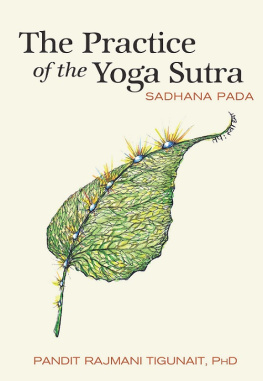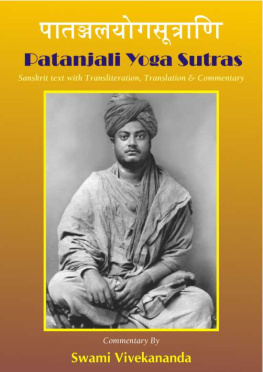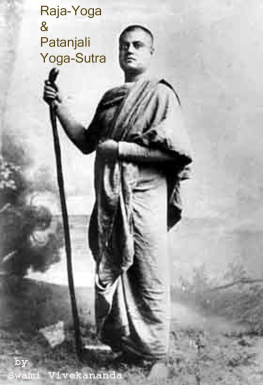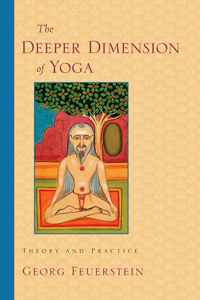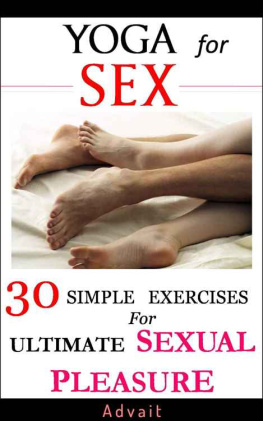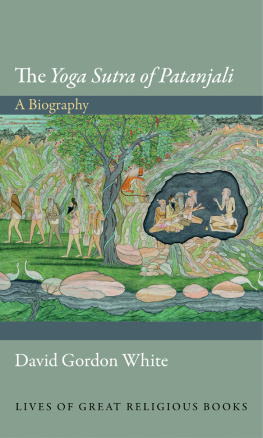Pandit Rajmani Tigunait - The Secret of the Yoga Sutra
Here you can read online Pandit Rajmani Tigunait - The Secret of the Yoga Sutra full text of the book (entire story) in english for free. Download pdf and epub, get meaning, cover and reviews about this ebook. year: 2014, publisher: Himalayan Institute, genre: Religion. Description of the work, (preface) as well as reviews are available. Best literature library LitArk.com created for fans of good reading and offers a wide selection of genres:
Romance novel
Science fiction
Adventure
Detective
Science
History
Home and family
Prose
Art
Politics
Computer
Non-fiction
Religion
Business
Children
Humor
Choose a favorite category and find really read worthwhile books. Enjoy immersion in the world of imagination, feel the emotions of the characters or learn something new for yourself, make an fascinating discovery.

- Book:The Secret of the Yoga Sutra
- Author:
- Publisher:Himalayan Institute
- Genre:
- Year:2014
- Rating:5 / 5
- Favourites:Add to favourites
- Your mark:
- 100
- 1
- 2
- 3
- 4
- 5
The Secret of the Yoga Sutra: summary, description and annotation
We offer to read an annotation, description, summary or preface (depends on what the author of the book "The Secret of the Yoga Sutra" wrote himself). If you haven't found the necessary information about the book — write in the comments, we will try to find it.
Pandit Rajmani Tigunait: author's other books
Who wrote The Secret of the Yoga Sutra? Find out the surname, the name of the author of the book and a list of all author's works by series.
The Secret of the Yoga Sutra — read online for free the complete book (whole text) full work
Below is the text of the book, divided by pages. System saving the place of the last page read, allows you to conveniently read the book "The Secret of the Yoga Sutra" online for free, without having to search again every time where you left off. Put a bookmark, and you can go to the page where you finished reading at any time.
Font size:
Interval:
Bookmark:
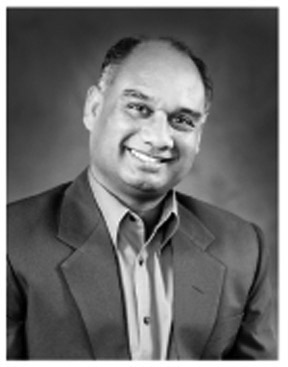
PANDIT RAJMANI TIGUNAIT, PHD, is a modern-day master and living link in the unbroken Himalayan Tradition. He embodies the yogic and tantric wisdom which the Himalayan Tradition has safeguarded for thousands of years. Pandit Tigunait is the successor of Sri Swami Rama of the Himalayas and the spiritual head of the Himalayan Institute. As a young man he committed himself to arduous spiritual practice and studied with renowned adepts of India before being initiated into the lineage of the Himalayan Tradition by his master, Sri Swami Rama, in 1976.
Pandit Tigunait is fluent in Vedic and Classical Sanskrit and holds two doctorates, one from the University of Allahabad (India), and another from the University of Pennsylvania. As a leading voice of YogaInternational.com and the author of 15 books, his teachings span a wide range, from scholarly analysis and scripture translation to practical guidance on applying yogic wisdom to modern life. Over the past 35 years, Pandit Tigunait has touched innumerable lives around the world as a teacher, guide, author, humanitarian, and visionary spiritual leader.
Devanagari, Transliteration, and Translation
SUTRA 1:1
atha yognusanam 1
Now begins the instruction on the practice of Yoga.
SUTRA 1:2
yogacittavttinirodha 2
Complete mastery over the roaming tendencies of the mind is Yoga.
SUTRA 1:3
tad drau svarpevasthnam 3
Then the Seer becomes established in its essential nature.
SUTRA 1:4
vttisrpyamitaratra 4
Elsewhere [the Seer] conforms to the roaming tendencies of the mind.
SUTRA 1:5
vttaya pacatayya klikli 5
The tendencies that cause the mind to rotate are fivefold. They are either afflicting or non-afflicting.
SUTRA 1:6
pramaviparyayavikalpanidrsmtaya 6
The five mental functions are correct understanding, false understanding, imagination, dreamless sleep, and memory.
SUTRA 1:7
pratyaknumngam pramni 7
Correct understanding is threefold: sense perception, inference, and revelation documented in the scriptures.
SUTRA 1:8
viparyayo mithyjnamatadrpapratiham 8
Mistaking the unreal for the real is false understanding. False understanding is not grounded in reality; instead it corresponds to that which has no ground.
SUTRA 1:9
abdajnnupt vastunyo vikalpa 9
Imagination is knowledge, which due to the use of words appears to have content but in reality is devoid of content.
SUTRA 1:10
abhvapratyaylamban vttirnidr 10
Swirling of the mind around the cognition of non-being is dreamless sleep.
SUTRA 1:11
anubhtaviaysampramoa smti 11
Not being completely disconnected from the objects of previous experiences is memory.
SUTRA 1:12
abhysavairgybhy tannirodha 12
That can be controlled through practice and non-attachment.
SUTRA 1:13
tatra sthitau yatnobhysa 13
Ardent effort to retain the peaceful flow of mind free of roaming tendencies isabhyasa.
SUTRA 1:14
sa tu drghaklanairantaryasatkrsevito dhabhmi 14
That becomes firm only when done for a long period of time, with no interruption, and with reverence.
SUTRA 1:15
dnuravikaviayavitasya vakrasaj vairgyam 15
Non-attachment, known asvashikara samjna, belongs to the one who is free from the craving for sense objects and objects mentioned in the scriptures.
SUTRA 1:16
tatpara puruakhyterguavaityam 16
The highest level of non-attachment, leading to self-realization, takes place when the aspirant is free from all forms of desire, including the desires resulting from the interplay ofsattvic, rajasic,andtamasicforces of nature.
SUTRA 1:17
vitarkavicrnandsmitrpnugamt samprajta 17
Samprajnata samadhiis accompanied either by a gross object, a subtle object, joy, or the feeling of I-am-ness.
SUTRA 1:18
virmapratyaybhysaprva saskraeonya 18
The other [higher samadhi] is preceded byabhyasa, which brought all cognitions to a complete halt. What remains is thesamskara[of abhyasa itself].
SUTRA 1:19
bhavapratyayo videhapraktilaynm 19
The experience of the higher level of samadhi is innate to [extraordinary yogis technically known as]videhaandprakritilaya.
SUTRA 1:20
raddhvryasmtisamdhiprajprvaka itarem 20
In the case of others, it [samadhi] is preceded by faith, vigor, retentive power, stillness of mind, and intuitive wisdom.
SUTRA 1:21
tvrasavegnmsanna 21
Samadhi is near for those whose aspiration is steadfast.
SUTRA 1:22
mdumadhydhimtratvt tatopi viea 22
Depending on whether the seekers steadfast aspiration is mild, intermediate, or supreme, there are further distinctions.
SUTRA 1:23
varapraidhndv 23
From trustful surrender to Ishvara [God], samadhi also comes.
SUTRA 1:24
kleakarmavipkayairaparma puruaviea vara 24
Ishvara [God] is a unique being untouched by afflictions, karmas, the results of karmas, and the repository of karmas.
SUTRA 1:25
tatra niratiaya sarvajabjam 25
Therein [in Ishvara] lies the seed of unsurpassed omniscience.
SUTRA 1:26
sa ea prvemapi guru klennavacchedt 26
He is the one who has been the preceptor of all previous teachers for He is not limited by time.
SUTRA 1:27
tasya vcaka praava 27
Pranava[om] is the denoter of That [Ishvara].
SUTRA 1:28
tajjapastadarthabhvanam 28
Repetition of That [pranava] means to reflect on its meaning.
SUTRA 1:29
tata pratyakcetandhigamopyantarybhvaca 29
From that comes the experience of Inner Being as well as the elimination of impediments.
SUTRA 1:30
vydhistynasaayapramdlasyvirati-bhrntidaranaalabdhabhmikatvnavasthitatvni cittavikepstentary 30
Disease, mental inertia, doubt, carelessness, sloth, inability to withdraw from sense cravings, clinging to misunderstanding, inability to reach the goal [samadhi], and inability to retain it throw our mind outward; they are obstacles.
SUTRA 1:31
dukhadaurmanasygamejayatvavsapravs vikepasahabhuva 31
Pain, mental agitation, unsteadiness or trembling of limbs, [abnormal or disturbed] inhalation and exhalation all arise with the obstacles.
SUTRA 1:32
tatpratiedhrthamekatattvbhysa 32
Meditation on one single reality is the way to overcome these obstacles.
SUTRA 1:33
maitrkarumuditopek sukhadukhapuypuya- viay bhvantacittaprasdanam 33
Transparency of mind comes by embracing an attitude of friendliness, compassion, happiness, and non-judgment toward those who are happy, miserable, virtuous, and non-virtuous.
SUTRA 1:34
pracchardanavidhrabhy v prasya 34
Transparency of mind also comes by practicing pranayama that involves forceful exhalation and breath retention.
SUTRA 1:35
viayavat v pravttirutpann manasa sthitinibandhin 35
A unique cognition pertaining to a sense object arising from within also anchors the mind tosthiti, the peaceful flow free from all thought constructs.
SUTRA 1:36
viok v jyotimat 36
The state of consciousness free from sorrow and anguish and infused with inner light also anchors the mind tosthiti, the peaceful flow free from all thought constructs.
SUTRA 1:37
vtargaviaya v cittam 37
Or the ability to retain the peaceful flow of mind comes by focusing on someone who is free from all desire.
Font size:
Interval:
Bookmark:
Similar books «The Secret of the Yoga Sutra»
Look at similar books to The Secret of the Yoga Sutra. We have selected literature similar in name and meaning in the hope of providing readers with more options to find new, interesting, not yet read works.
Discussion, reviews of the book The Secret of the Yoga Sutra and just readers' own opinions. Leave your comments, write what you think about the work, its meaning or the main characters. Specify what exactly you liked and what you didn't like, and why you think so.

